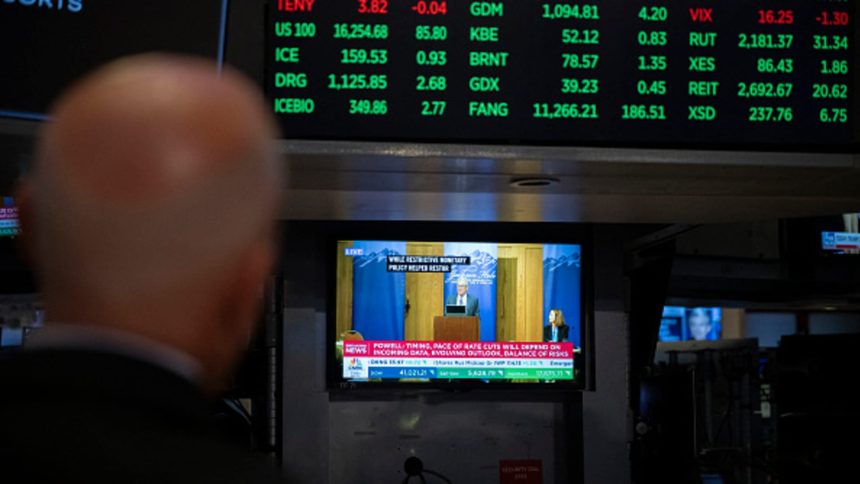Federal Reserve interest rate hikes were blamed for the tech-stock carnage two years ago. With the central bank gearing up to begin lowering rates at its September meeting, some investors might assume it’s time to buy tech. There’s just one problem: It’s not that simple. That complexity is playing out in the market ahead of what’s universally expected next month to be the Fed’s first rate cut of its tightening cycle that began in March 2022. It seems investors are willing to sell tech and buy the rest of the market — or, in other instances, buy tech and sell the rest. Lately, it’s been the former as the tech-dominated Nasdaq remains 5% or so off its all-time highs, and the broader Dow Jones Industrial Average on Monday closed back at a record high. Jim Cramer posed an important question Tuesday about the market’s broadening: “Can tech go up with rates coming down?” Post-Covid rate hikes To help answer that question, let’s think back to 2022. We were still coming out of the Covid recession, the market, which was awash in liquidity, entered the year at record highs, and rates were at zero percent. Inflation was starting to pick up, and it was becoming increasingly apparent that the Fed had a major inflation problem on its hands as the combination of record-high money supply and supply chain shocks were coming to a head as the world was reopening from pandemic lockdowns and consumers felt “long on money, short on time.” We all knew at the time that Fed rate hikes were coming. We didn’t know how many or how severe they would be. In the end, 11 total rate increases from zero to 0.25% to the current 5.25% to 5.5% was nothing short of extraordinary. In typical Wall Street fashion, the move was to sell first and ask questions later. As large money managers recalibrated their views of appropriate multiples and updated discount rates, the market took a beating in 2022, ultimately trading down to just over 15 times forward earnings in the back half of the year from more than 21 times at the start. The S & P 500 lost nearly 20% that year, its worst since 2008. Stock valuation models To understand how rates impact the perceived value of stocks — not just prices — equities are generally valued one of two ways : on price to earnings (P/E) or on a discounted cash flow (DCF) model. When it comes to P/E ratios, investors are always going to look to pay a lower multiple when rates are increasing because the “risk-free” returns of bonds become more competitive versus the risky returns of stocks and earnings estimates are going to be at a somewhat higher risk then rates are increasing as higher rates slow economic growth. Those higher borrowing costs also make it harder to finance growth. As for DCF valuations, higher rates result in lower present values of future cash flows. As the pace of rate hikes slowed last year, with the last move in July 2023, the stock market roared back. Aided by a stampede to buy anything related to artificial intelligence, the S & P 500 rose 24% last year. Currently, with inflation turning the corner, the Fed is expected to cut rates 100 basis points before the end of 2024. Sure, we’ll take it, but the expected pace of cuts is not expected to be anywhere near the pace of the hikes. Many Wall Street strategists are calling for the S & P 500 to end the year higher than it is now. The index as of Tuesday trading was up about 18% year to date. In its ascendency, the S & P 500 is trading back up to 21 times forward earnings — right around the level at the end of 2021 when rates were at zero. That puts us pretty close to the upper range of the S & P 500’s historical forward valuation. Further upside from here will likely take some time as we look for earnings growth to catch up to the current valuations. It could happen over the next few quarters. Upcoming rate cuts While lower rates do indeed tend to support equity valuations, there is something of an upper limit as to what the market is going to pay in terms of the price-to-earnings multiple, regardless of the level of rates. The tech sector is already trading at the high end of its historical valuation range. It’s also valued well above the other sectors. Beyond tech, lower rates stand to be more beneficial to other parts of the market. That’s why investors have been taking profits in their tech winners and buying stocks that haven’t done as well but have earnings that are more sensitive to interest rates, such as Club holdings Stanley Black & Decker and Best Buy . Those companies benefit from new home formation, which may see an uptick as mortgage rates come down during the looming rate-cutting cycle. That’s not to say that tech earnings can’t benefit from lower rates. We know all too well how high financing costs have impacted the pace of deal activity for Club names like Palo Alto Networks and Salesforce . It is, however, our goal to point out that we can’t look at the current market through the lens of, “high interest rates bad, low interest rates good,” or think that multiples can keep expanding, unchecked, just because rates are coming down. We need to be much more surgical about our approach and ask ourselves some big-picture questions. Where do current valuations stand and is it reasonable to expect some further multiple expansion? That’s a bit easier to do in sectors outside of tech. In what parts of the economy are lower rates going to lead to the greatest increases in earnings in 2025? That’s what the market is starting to focus on as we work our way into the fourth quarter of 2024. Is a diversified portfolio going to allow us to benefit regardless of the outcome? We think so, but some altering of sector exposures may be warranted. Bottom line We’re not sounding the alarm on technology. In fact, we still think there’s plenty of tech upside out there given the secular growth drivers such as AI. But material upside from here in tech will come from earnings growth, not simply further multiple expansion regardless of rate cuts. Rather, we wanted to provide a deeper understanding of the questions we find ourselves asking internally and to explore why the market has seen an uptick in volatility despite it becoming increasingly clear that rates are coming down. The upcoming U.S. presidential election and general geopolitical tensions are playing into the volatility. But that’s a topic for another day. (See here for a full list of the stocks in Jim Cramer’s Charitable Trust is long.) As a subscriber to the CNBC Investing Club with Jim Cramer, you will receive a trade alert before Jim makes a trade. Jim waits 45 minutes after sending a trade alert before buying or selling a stock in his charitable trust’s portfolio. If Jim has talked about a stock on CNBC TV, he waits 72 hours after issuing the trade alert before executing the trade. THE ABOVE INVESTING CLUB INFORMATION IS SUBJECT TO OUR TERMS AND CONDITIONS AND PRIVACY POLICY , TOGETHER WITH OUR DISCLAIMER . NO FIDUCIARY OBLIGATION OR DUTY EXISTS, OR IS CREATED, BY VIRTUE OF YOUR RECEIPT OF ANY INFORMATION PROVIDED IN CONNECTION WITH THE INVESTING CLUB. NO SPECIFIC OUTCOME OR PROFIT IS GUARANTEED.
Federal Reserve interest rate hikes were blamed for the tech-stock carnage two years ago.
With the central bank gearing up to begin lowering rates at its September meeting, some investors might assume it’s time to buy tech. There’s just one problem: It’s not that simple.
Read the full article here
News Room




